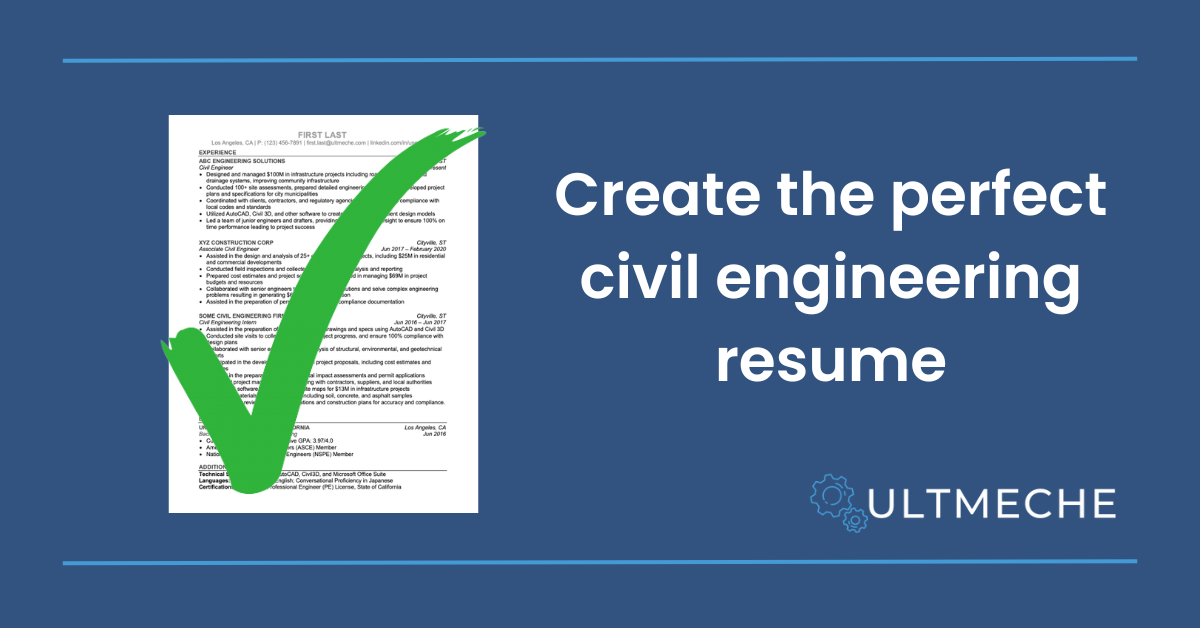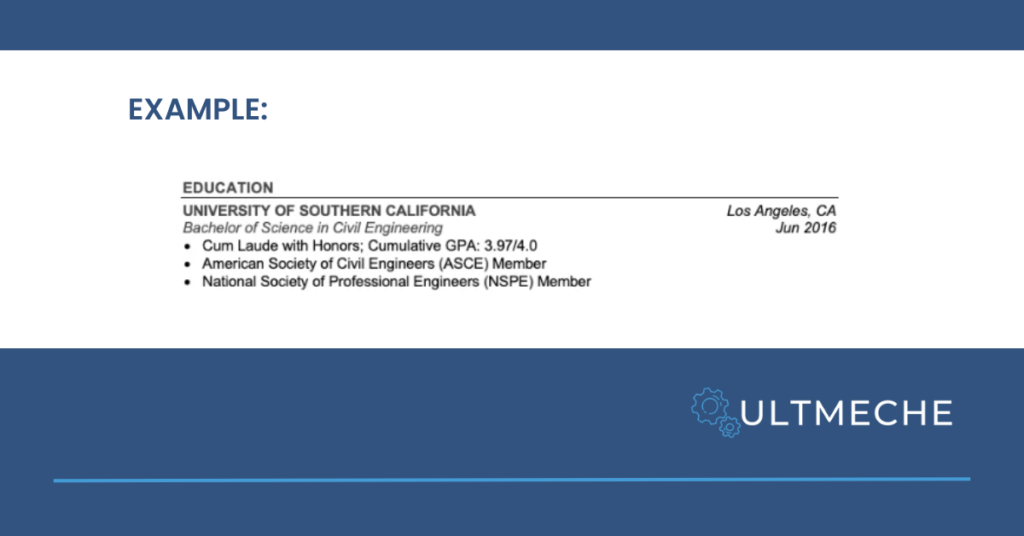A good civil engineer resume template can be the difference between landing your dream role and falling to the bottom of the pile. The competition for top roles is fierce, and only the best get an interview. How can you make sure your resume is perfect so that you’re one of the top candidates in the applicant pool?
Let’s take a look at what a good resume should look like and go through it step-by-step as we craft a resume that is both effective and clear.

The Civil Engineer Resume Template
Every resume you create should be personalized for the hiring business. This often means that creating a template that you can quickly and easily adapt is the most time-efficient and impactful way to apply for top jobs.
Creating an effective civil engineering resume template requires careful attention to detail. To help you craft a resume that stands out, here’s a step-by-step guide tailored to civil engineers at any stage of their careers.
Step 1: Formatting and Setup
The first step in creating a professional civil engineering resume is to ensure that it’s formatted correctly. The layout of your resume plays a crucial role in how easily hiring managers can navigate the information you provide.
Some businesses have preferred styles that you might need to be aware of. The Harvard resume template and Google XYZ template are popular in engineering and technology businesses.
Choosing the Right Layout and Format
- Simple and Clean Design: Opt for a straightforward design without overly complex design elements. Avoid using Canva templates or other alternatives that are not easily readable for an ATS (applicant tracking system.)
- Consistent Font Style: Use a professional font (Arial, Calibri, or Times New Roman), and maintain a readable and consistent font hierarchy throughout the resume.
- Margins and Spacing: Make sure your resume has reasonable margins and ensure there’s adequate spacing between sections and bullet points to emphasize each section for quick scanning.
- File Type: Save your resume as a PDF to preserve formatting, ensuring it appears the same across all devices and systems. You can also use a .doc or .docx file if needed.
Structuring the Resume
- Reverse Chronological Order: Always list your most recent experiences and qualifications first. These are typically your most advanced qualifications or positions.
- Section Headers: Use clear headers for each section (e.g. “Experience”) to help hiring managers easily navigate your resume and pick out any key information.
- Bullet Points: Organize your resume in bullet points for clarity and ease of reading.
Bonus tip: Take advantage of the job listing. Pick out keywords and phrases used by the hiring company and mirror them back in your own resume. This can help them to more quickly identify that you’re a good fit for the role.

Step 2: Contact Information
Without your contact information, it can be very difficult to arrange an interview. You should always include details at the beginning of your civil engineering resume in a place that’s clear and easy to refer back to.
What to Include:
- Full Name: At the very top, your name should be the largest text on the page, making it easy for recruiters to identify your resume.
- Phone Number: Make sure you include a reliable phone number where you can be easily reached.
- Professional Email Address: Use a professional email address that ideally includes your full name (e.g., john.smith@example.com).
- LinkedIn Profile: If you have a professional LinkedIn profile that’s up-to-date, include it. This can give recruiters additional insights into your career history and how you work and interact with others in the industry day-to-day.
- Professional Website or Portfolio: If relevant, especially for roles involving design or project management, include a link to a portfolio showcasing your best work.
Step 3: Experiences
The experience section is the most important part of your civil engineering resume. This is where you demonstrate your hands-on skills and professional achievements.
Structuring the Experience Section
- Company Name and Location: Include the name of the employer and the location (city, state).
- Job Title: Add your job title to clearly indicate the role you held.
- Dates of Employment: Specify the duration of your employment in a month/year format.
- Key Responsibilities and Achievements: Use bullet points to detail your responsibilities and the impact you made. Prioritize experiences that are most relevant to the job you’re applying for.
How to Write Strong Bullet Points
- Action-Oriented Language: Begin each bullet point with a strong action verb (e.g., “Designed,” “Managed,” “Led”) to emphasize your role.
- Quantify Achievements: Wherever possible, quantify your accomplishments with numbers (e.g., “Reduced project costs by 15%,” “Managed a team of 10 engineers”).
- Relevance: Tailor your descriptions to align with the job description, highlighting the skills and experiences most relevant to the position.
EXAMPLE:
- Assisted in the design and analysis of 25+ civil engineering projects, including $25M in residential and commercial developments.
Step 4: Education
Your educational background is particularly important in the field of civil engineering. This section should highlight your formal education and any relevant coursework or honors.
What to Include:
- Institution Name: Include the full name of the university or college where you obtained your degree.
- Degree(s) Obtained: Clearly state your degree (e.g., Bachelor of Science in Civil Engineering).
- Graduation Date: Provide the month and year of your graduation.
- Relevant Coursework or Honors: If applicable, list relevant coursework, honors, or distinctions that may set you apart.

Step 5: Additional Details
The final section of your resume should include any additional details that further demonstrate why you’re perfect for the role. This could cover technical skills, certifications, licenses, or memberships to professional bodies or organizations.
Key Additional Sections
Here are a few examples you may want to consider.
Technical Skills
- Software Proficiency: List any relevant software tools you are proficient in, such as AutoCAD, Civil 3D, SAP2000, or Revit.
- Other Technical Skills: Include any additional technical skills like GIS applications, project management software, or advanced mathematical tools.
Certifications and Licenses
- Industry-Standard Certifications: Include any certifications that are relevant to civil engineering, such as the Professional Engineer (PE) License or the Fundamentals of Engineering (FE) Certification.
- Safety Certifications: Mention any OSHA certifications or other safety training relevant to construction and engineering roles.
Professional Affiliations
- Memberships: List any memberships in professional organizations like the American Society of Civil Engineers (ASCE) or the Institution of Civil Engineers (ICE).
Languages and Volunteer Work
- Languages: If you speak multiple languages, particularly those that might be relevant to international projects, include them.
- Volunteer Work: Volunteer experiences that demonstrate leadership or technical skills can also be valuable, particularly if you have little formal experience.
Get The Civil Engineer Resume Template
Want to get your hands on the premium template that will 10x your chances of landing your next big role? You can find it here.
About the author

Mollie Buttery
Writer | SEO | Articles & Blog Posts | Social Media
Mollie supports ULTMECHE through website growth, social media, SEO, and also other digital marketing tricks. Mollie has 10+ years experience of in house and freelance marketing experience in industries such as Finance, Law, SAAS, Automotive, Building Services, Commerce, and more. Some of her favorite writing topics consist of sports and finance. Mollie has been key to the growth of ULTMECHE’s SEO and digital marketing efforts.
